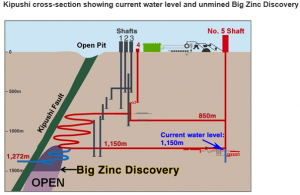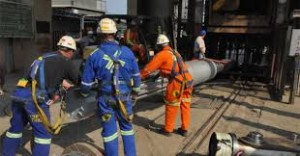Robert Friedland's Ivanhoe Mines (IVN:TSX) has completed dewatering activities to the main working level of the historic and high-grade Kipushi copper-zinc-germanium-lead and precious-metals mine (68% IVN, 32% state-mining company) in the Democratic Republic of Congo (DRC). The mine’s underground workings were extensively flooded during the previous 18 years when the mine was on care-and-maintenance as a former state-owned asset. The main working level of the mine is at 1,150m which has now been reached. They expect to complete dewatering to the lowest levels of the mine shafts at 1,270m in the first quarter of next year with a 100-hole, 20,000m drill campaign to follow. Drilling is expected to confirm and potentially grow the historic resource estimates within the Big Zinc and Fault zones and to bring them up to NI43-101 standards.
"Steelwork and equipment are being progressively replaced and upgraded as the water level drops, providing access for drilling and advancing us to a very significant milestone in the redevelopment of the Kipushi Mine," said Mr. Lars-Eric Johansson (President and CEO of Ivanhoe).
The Fault Zone is a high-grade copper-zinc-lead zone that has a strike length of 600m and that is known to extend 1,800m below surface based on drilling data from its former operator, the state-owned Gecamines La Generale des Carrieres et des Mines.
The Big Zinc zone is a high-grade zinc zone next to the Fault Zone which has never been mined but is known to extend from 1,200m to at least 1,640m deep and remains open at depth. Data compiled from Gecamines indicates multiple, steeply-dipping drill holes intersected extremely high-grade zinc intercepts of 42-45% zinc over 60-100m intervals.
Ivanhoe believes Kipushi holds more high-grade mineralization at depth and intends to use the access granted by dewatering activities to use modern exploration techniques to define further mineralization especially within the Big Zinc zone which has yet to be a priority in any previous exploration..

Now that dewatering is complete the company is poised to do confirmatory drilling of historic resources (source: Ivanhoe Mines)
The historic resources show the Fault zone to host Measured and Indicated resources of 16.9Mt at 2.32% copper and 16.76% zinc with an additional 9Mt at 1.93% copper and 23.32% zinc in the Inferred category. The Big Zinc is estimated at 4.7Mt at 0.76% copper and 38.55% zinc. The resource estimate for the Big Zinc zone only used data to the 1,500m level although Gecamines' drilling confirmed mineralization to continue to 1,640m and below. Gecamines' was primarily interested in the copper component of the mine and therefore it didn't warrant them doing extensive work on the Big Zinc zone.
Kipushi produced 6.6Mt of zinc and 4Mt of copper at average grades of 11% and 7% from 1924-1993. The mine was closed in 1993 due to the outbreak of war across the country. The mine then produced 278 tonnes of germanium from 1956-1978. Beyond the extremely high-grade zinc and copper zones at Kipushi, historic data indicates that production at the mine included precious metals although the details were not disclosed during the Belgium colonial era.
Remember, Kipushi, which is the best undeveloped zinc deposit globally, is the third 'best' asset held by Ivanhoe. The company's world-class Platreef project in South Africa hosts one of the largest undeveloped platinum deposits in the world with massive mining thickness' which will make for a completely new style of wide-vein platinum mining in South Africa. Kamoa, the second 'best' asset held by the company, is one of the best copper projects in the world and is located just west of Kipushi. Kamoa hosts nearly 40 billion pounds of copper at 3% average grade.
The first quarter of 2014 will have a lot of key news flow for Ivanhoe. Their Platreef project is progressing towards a bulk-sample and Kamoa is moving towards releasing a feasibility study in 2014. Combine this with the completion of dewatering and drill results from Kipushi and there are key catalysts for Ivanhoe within the next few months.
Read: Ivanhoe Mines Reports Dewatering Progress at Historic Kipushi Mine






















